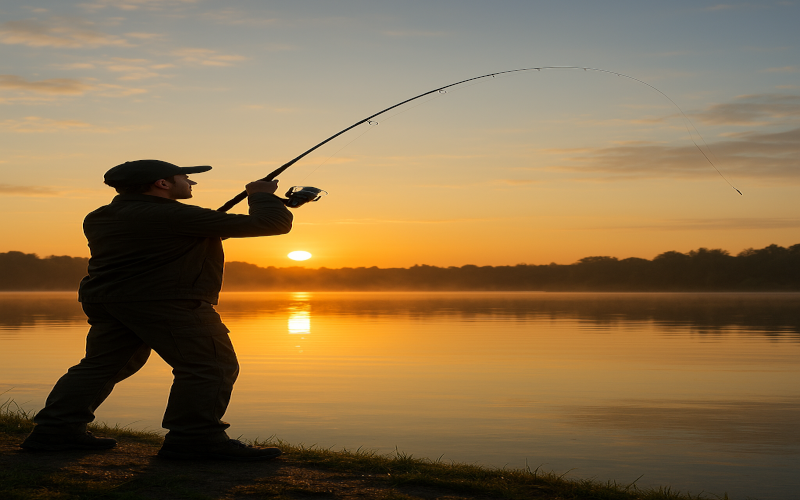Disclaimer: This post may have affiliate links. As an Amazon Associate, I earn from qualifying purchases.
Casting Like a Pro: The First Skill Every Angler Must Master
September 23, 2025 - Reading time: 8 minutes
Learn how to cast like a pro with overhead, sidearm, and roll techniques. Boost your accuracy and confidence on the water.

🎣 Fishing may look simple to the outsider: toss a line in the water, wait for a bite, reel in your dinner. But every seasoned angler knows that the success of the day often hinges on one thing, the cast. Casting is the delivery system for your lure, bait, or fly. Without accuracy, smoothness, and control, you’re not fishing, you’re just feeding the water.
Whether you’re tossing a spinner at bass, flipping a jig under a dock, or rolling a fly over a shaded stream, mastering casting is step one in becoming an angler who consistently catches fish.
Why Casting Matters More Than You Think
Think of your cast like a delivery driver. If your package (lure) doesn’t land on the right doorstep (strike zone), it doesn’t matter how good the product is. Accuracy is everything. Cast too short, and the fish never sees it. Cast too far, and your lure looks unnatural. Cast too hard, and you might spook every fish within 30 yards.
Good casting isn’t about brute force, it’s about finesse. The goal is to make your bait land softly, naturally, and exactly where it should. When you get that right, your catch rate skyrockets.
The Overhead Cast (Beginner’s Best Friend)
The overhead cast is the most common and beginner-friendly cast, perfect for wide-open spaces like lakes and ponds.
How to do it:
-
Hold the rod with your dominant hand near the reel, and your other hand at the butt end for stability.
-
Open the bail (if using a spinning reel) and trap the line against the rod with your finger.
-
Bring the rod tip smoothly behind your shoulder, like you’re drawing back a bow.
-
Swing the rod forward in a smooth, controlled motion.
-
Release the line as the rod tip points upward, around the 1 o’clock position.
Common mistakes:
-
Jerking the rod too hard → tangles or “bird’s nests.”
-
Letting go too early → bait flies sky-high.
-
Letting go too late → lure lands 3 feet in front of you.
Pro Tip: Think dart throw, not baseball pitch. Smoothness wins every time.
The Sidearm Cast (For Tight Spots)
Sometimes overhead casting just isn’t an option. Maybe you’re under tree branches, working near docks, or fishing under a low bridge. Enter the sidearm cast.
How it works:
-
Keep the rod parallel to the ground.
-
In one smooth motion, swing it sideways like a tennis forehand.
-
Release the line when the rod tip points at your target.
This cast keeps your line low and fast, perfect for sliding lures under cover where big bass love to hide.
Mistake to avoid: Don’t over-snap your wrist it’s about fluidity, not power.
The Roll Cast (Fly Fishing Essential)
Fly fishing adds its own twist. In tight streams, you can’t always backcast. That’s where the roll cast shines.
The roll cast in action:
-
Point your rod tip low, line trailing downstream.
-
Lift the rod smoothly to load tension, keeping the line in a D-loop behind you.
-
Roll the rod forward, allowing the line to unfurl and land softly on the water.
It’s not flashy, but it’s lifesaving in brushy streams and narrow creeks.
Gear That Makes Casting Easier
Let’s be honest: technique matters, but gear plays a big role too. A cheap rod with sloppy guides or a reel with sticky drag makes smooth casting almost impossible.
👉 BEST SELLER | 20% OFF BIG DEAL This bestseller rod-and-reel combo is engineered for distance and accuracy, making every cast smoother and more controlled. If you want fewer tangles and better results, upgrading your gear is the easiest win.
Practice Makes Perfect (No Water Required)
One of the best things about casting is you don’t need a lake to practice. Many pros recommend using a practice plug (a small rubber weight) and casting in your backyard or a park.
Tips for practicing:
-
Place paper plates on the ground as “targets.”
-
Practice distance by gradually stepping back.
-
Work on smoothness: no jerks, no snaps, just rhythm.
Ten minutes a day builds muscle memory that translates directly to the water.
Casting Drills for Faster Improvement
-
Target Drill: Place three hula hoops or buckets at different ranges. Practice landing your lure inside each.
-
Obstacle Drill: Set up chairs or sticks as “trees” and practice sidearm casts under them.
-
Accuracy Under Pressure: Try casting while sitting down or kneeling and you’ll learn to adapt body position.
Common Casting Problems (and Fixes)
-
Problem: Lure lands short.
-
Fix: Release a split-second earlier.
-
-
Problem: Line tangles at reel.
-
Fix: Check for overfilled spool and use smoother motions.
-
-
Problem: Lure hits the water too hard.
-
Fix: Reduce power; focus on smooth acceleration, not force.
-
The Mindset of a Great Caster
Casting is as much mental as physical. You need patience, consistency, and the willingness to fail (a lot) before you improve. Even pros still practice. They know every perfect cast means less wasted time and more time fighting fish.
Casting is the foundation of fishing. Master it, and you unlock every other technique like flipping, pitching, trolling, jigging, because all of them start with accuracy and control.
So grab your rod, hit the backyard, and practice until smoothness feels natural. Then, when you’re on the water, every cast becomes an invitation for a fish to strike.
And if your gear’s holding you back? Don’t fight it. Upgrade today:
👉 BEST SELLER | 20% OFF BIG DEAL
Hunting & Fishing Life - All-season outdoors living, guides, and gear reviews.
HookdLife - Outdoor stories, gear talk, and the hooked life culture.
Country Redneck - Country grit, humor, and real-life outdoor living.
Coffee & Grits - Southern mornings, hard work, and good coffee.
WolvesTale - Frontier tales and wilderness fiction inspired by the wild.
MTDLN Media Group - Explore our full outdoors and storytelling network.
